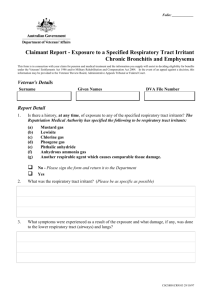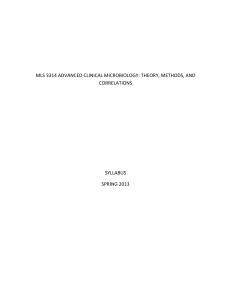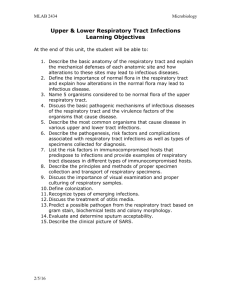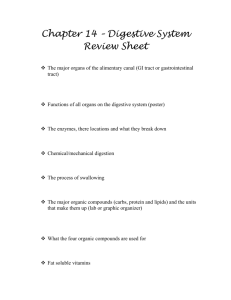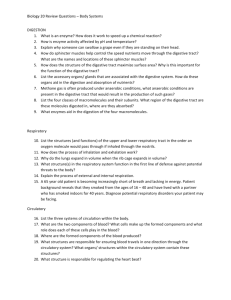1- Barriers to infection,and Introduction to Immunology-1
advertisement
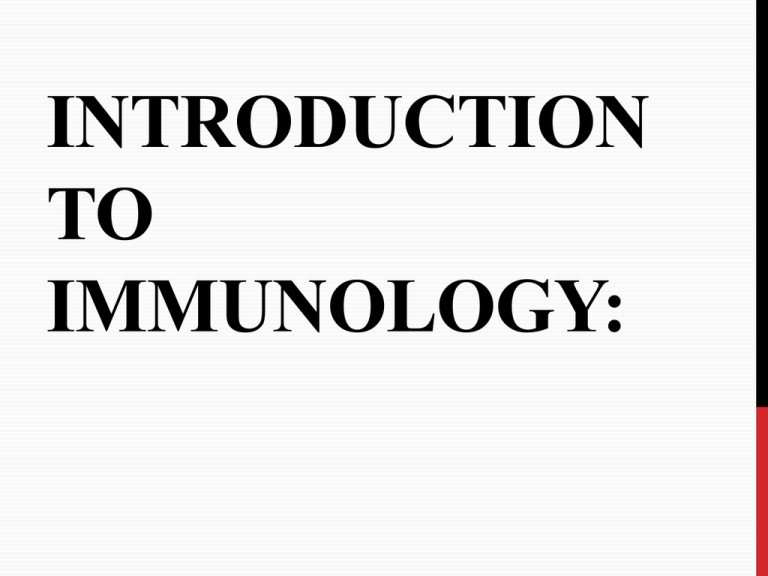
INTRODUCTION TO IMMUNOLOGY: DEFINITIONS Immunity: resistance to disease, specifically infectious disease and tumors. The immune system: the collection of cells, tissues, and molecules that mediate resistance to infections. The immune response: the coordinated reaction of these cells and molecules to infectious microbes. History Documents show that as early as AD 1000, the Chinese custom existed of making children inhale powders made from the crusty skin lesions of patients recovering from smallpox. Edward Jenner noticed that milkmaids were generally immune to smallpox. Jenner proposed that cowpox can be used to immunize children against small pox virus (small pox vaccine). On 14 May 1796, Jenner tested his hypothesis by inoculating an eight-year-old boy by pus from cowpox blisters on the hands of a milkmaid who had caught cowpox from a cow. The boy was later challenged with small pox material and showed no sign of infection. N In 1876; Robert Koch transmitted anthrax from in vitro culture to animals; he proved that the microbe is the causative agent of disease. Louis Pasteur (1881), developed the first three veterinary attenuated vaccines: chicken cholera, anthrax and rabies. In 1883, Metchnikoff observed the phagocytosis of fungal spores by leukocytes and advanced the idea that immunity was due to WBCs. Tissues And Organs Of The Immune System Primary lymphoid organs (development & education) Bone marrow. Thymus. • Secondary lymphoid organs (sites where immune cells make contact with each another) Spleen. Lymph nodes. Mucosal associated lymphoid tissues (MALT) e.g. tonsils. THYMUS & BONE MARROW BARRIERS TO INFECTION: Human body has several barriers: • Physical barriers • Chemical barriers • Biologic barriers These barriers provide the first line of defense against the entry of microbes. The Physical Barriers: o o o o Skin and Mucus membranes Respiratory tract Urinary tract GIT. SKIN: The initial mechanical barrier. • The outermost layer of epidermis (stratum corneum), is composed of dead tightly layered squamous cells. This layer is an inhospitable dry surface. • Continuously dividing keratinocytes provides a constant detachment of squamous cells and microbes. N - N Mucous Membranes: • The epithelium of mucous membranes line the body cavities. • This epithelium contains goblet cells that secrete mucus. • Mucus viscosity traps the inhaled microbes. • In GIT, the mucus protects the epithelial cells and underlying tissue from damage by digestive enzyme. Urinary Tract: The flashing action of urine (urination) washes away pathogens and prevent urinary tract infections. N Respiratory Tract: o The mucus trap invading microbes. o The hair-like rhythmically beating cilia of the epithelia lining the respiratory tract passages remove the secretions. o Alveolar macrophages play an important role in defence against microbes. GIT: intestinal peristalsis. THE CHEMICAL BARRIERS: o Skin o Gastrointestinal Tract (GIT) o Respiratory Tract and Lacrimal Secretions. Skin: • Sweat has slightly acidic PH of 5.5 and contains lysozyme that breaks down the bacterial peptidoglycan. • The RNAses and DNAses of skin destroy the microbial genetic material. • Several antimicrobial peptides e.g. α & β defensins which are induced by skin damage, inhibit microbial growth causing lysis. • The fatty acids and sebum (lipids) have antimicrobial action. The Gastrointestinal Tract: • The highly acidic environment of stomach (pH of 1 to 3) protects the intestines. • The secreted antimicrobial molecules (α defensine and cryptidin) of GIT destroy some pathogens. • The digestive action of the enzymes. Respiratory tract and lacrimal secretions: • In respiratory tract: β defensin and IgA has antimicrobial activity. • Production of tears; which contain IgA and lysozymes (protect the eye from pathogens). The Biologic Barriers: Commensal Microbes (normal flora): Microorganisms that exist in a symbiotic relationship with the body. How do commensals inhibit pathogenic colonization? o Production of bacteriocins (antibiotics). o Competitive depletion of essential nutrients. o Production of toxic products (vaginal lactic acid PH 4). o Stimulation of natural antibodies. Examples of common commensal Bacteria Body Area Common Commensal o Skin o Staphylococcus species o Upper respiratory tract, mouth, and throat. o Streptococcus (alpha hem.) Neisseria species. o Intestinal tract o Bacteroides and Escherichia coli. o Genital tract o Lactobacillus species N Establishment of Infection: Infectious diseases occur when a pathogenic organism invades human body barrier. This can be related to the following factors: o The microbial virulence o The pathogenic dose. o The port of entry. o The host immunity. N Pathogenic Dose: It is the minimum number of organisms required to establish an infection. Virulence Factors : Are microbial extracellular structures, proteins, enzymes and toxins that enable the microorganism to be a pathogen. Ports of Entry: o Ingestion. o Inhalation o Direct penetration Examples: Ingestion: •Bacteria: Salmonella. •Parasites: Entamoeba histolytica. •Viruses: Hepatitis A. Inhalation: •Bacteria: Mycobacterium tuberculosis •Fungi: Histoplasma. •Viruses: influenza Direct penetration: •Trauma: Clostridum tetani. •Needle stick: hepatitis B. •Arthropod bite: Malaria •Sexual transmission: Neisseria gonorrhoeae. •Transplacental: Rubella virus. • Skin penetration: Schistosoma.



